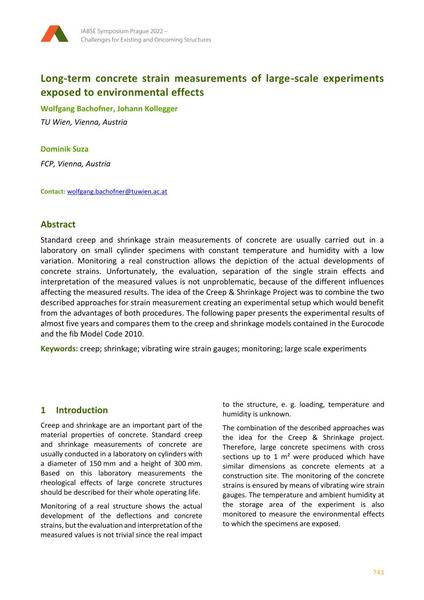Long-term concrete strain measurements of large-scale experiments exposed to environmental effects

|
|
|||||||||||
Détails bibliographiques
| Auteur(s): |
Wolfgang Bachofner
(TU Wien, Vienna, Austria)
Johann Kollegger (TU Wien, Vienna, Austria) Dominik Suza (FCP, Vienna, Austria) |
||||
|---|---|---|---|---|---|
| Médium: | papier de conférence | ||||
| Langue(s): | anglais | ||||
| Conférence: | IABSE Symposium: Challenges for Existing and Oncoming Structures, Prague, Czech Republic, 25-27 May 2022 | ||||
| Publié dans: | IABSE Symposium Prague 2022 | ||||
|
|||||
| Page(s): | 743-749 | ||||
| Nombre total de pages (du PDF): | 7 | ||||
| DOI: | 10.2749/prague.2022.0743 | ||||
| Abstrait: |
Standard creep and shrinkage strain measurements of concrete are usually carried out in a laboratory on small cylinder specimens with constant temperature and humidity with a low variation. Monitoring a real construction allows the depiction of the actual developments of concrete strains. Unfortunately, the evaluation, separation of the single strain effects and interpretation of the measured values is not unproblematic, because of the different influences affecting the measured results. The idea of the Creep & Shrinkage Project was to combine the two described approaches for strain measurement creating an experimental setup which would benefit from the advantages of both procedures. The following paper presents the experimental results of almost five years and compares them to the creep and shrinkage models contained in the Eurocode and the fib Model Code 2010. |
||||
| Copyright: | © 2022 International Association for Bridge and Structural Engineering (IABSE) | ||||
| License: | Cette oeuvre ne peut être utilisée sans la permission de l'auteur ou détenteur des droits. |
||||
